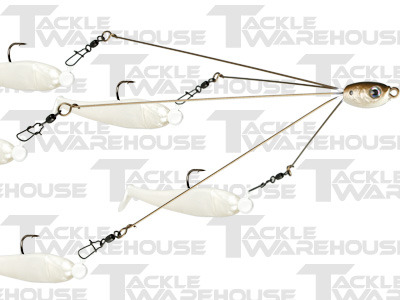Pictures of fish and various “set-ups” have been flooding the Internet for months now. And, I thought with spring right around the corner, it’d be a great time to throw out my opinions about the Alabama Rig. So, this week I’m going to discuss the finer points that I’ve discovered, while taking a closer look at these rigs. Let’s have a look, shall we?
To lead things off, I want to talk about the wire. There’s no doubt the wire strength and quality is going to make a huge difference in tournament situations. Working with cheap or light wire will leave you with a chance of breaking fish off. Make sure the wire strength matches the conditions and the size of the fish you’ll be fighting. Folks fishing in southern states may want to upgrade the strength of wire, while those of you in the Midwest may be able to get away with some lighter strength wires because we rarely see fish in the 6+ pound range. One of the finesse rigs I’ll be trying is the Paycheck Baits Donkey Thrasher because of the lighter wire, the ability to make the bait ball expand and contract by pumping the rod and lesser weight. Varying conditions and water clarity may offer you the chance to try differing gauges of wire and different styles of baits.
Next, let’s discuss line. Now, I’ve heard some guys fishing these rigs on lines other than braid, but my thoughts on this are as follows:
Unless you’re fishing in an area where you know you won’t be hung up, I think braid or a hybrid braid is the only choice for a few different reasons.
- First of all, these are expensive rigs – including the cost of baits, teasers, jig heads and the rig itself, you’re talking 20-35+ dollars per cast. I don’t know many anglers who can afford to lose 2-3 of these per outing!
- Second, braid will not stretch, and this is vital since you’re tossing 2-3 ounces per cast. A monofilament line will get weakened very fast no matter the strength after an hour of chuckin’ baits like this rig!
- Finally, with the creation of a bait ball in the water I really don’t think the line matters too much. The fish will be way too concentrated on the 5 lures swimming past that the line will be an afterthought. So why wouldn’t you stick with the strength and reliability of braid?
Swivels are the next topic. I believe this is the reason a fish will decide to hit a bait or not when this bait ball goes swimming by. I believe the less bulky and noticeable the swivels are, the better chance a fish is going to strike a bait. Here’s why: the swivel is the closest part of the rig to the actual hook. If they’re going to notice “something is up” it will be because of the swivel. Obviously, these have to be strong, high quality parts because they do have a lot of pressure put on them with the strike and hook-set, but they don’t have to be bulky and cumbersome either.
Finally, let’s discuss the head of the rig. Surprisingly, there are more options for the front of the rig than anything else. They range from a wire loop, to a minnow head imitation, to a full swim bait teaser. The purpose of the wire loop is to clearly tie the rig to the main line, but many of these have small barrel swivels attached to allow the rig to spin and move freely. The swim bait teaser is on a few to create a bigger, bulkier school of shad or minnows. Finally, the minnow head, like the Mann’s Slick Lures Alabama Rig, serves a few different purposes. The first being a weight to get the rig down into deeper depths if it’s made of led. It can also be made with a plastic head to keep it running shallower. Some have bigger lead heads to help it cast better without spinning or twisting. The added weight on the front gives it the kick it needs to fly straight on casts.
I hope you’ve all been able to take a few mental notes on these castable umbrella rigs! Eventually, I’ll blog about the different baits I have, and will try on these rigs. Be sure to visit again next week and stay Fishidy!


